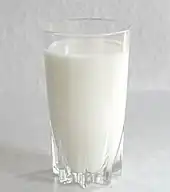Dairy product
Dairy products or milk products, also known as lacticinia, are food products made from (or containing) milk.[lower-alpha 1][1] The most common dairy animals are cow, water buffalo, nanny goat, and ewe. Dairy products include common grocery store food items in the Western world such as yogurt, cheese, milk and butter.[2][3] A facility that produces dairy products is known as a dairy.[lower-alpha 2][4] Dairy products are consumed worldwide to varying degrees (see consumption patterns worldwide).[5] Some people avoid some or all dairy products either because of lactose intolerance, veganism, or other health reasons or beliefs.

Types of dairy product
Milk


Milk is produced after optional homogenization or pasteurization, in several grades after standardization of the fat level, and possible addition of the bacteria Streptococcus lactis and Leuconostoc citrovorum. Milk can be broken down into several different categories based on type of product produced, including cream, butter, cheese, infant formula, and yogurt.
Milk varies in fat content. Skim milk is milk with zero fat, while whole milk products contain fat.
Milk is an ingredient in many confectioneries. Milk can be added to chocolate to produce milk chocolate.
- Scalded milk
- Condensed milk, milk which has been concentrated by evaporation, with sugar added for reduced process time and longer life in an opened can
- Evaporated milk, (less concentrated than condensed) milk without added sugar
- Baked milk is milk simmered on low heat for long time which results in mild caramelization. Particularly popular in Eastern Europe.
- Dulce de leche
- Malai
- Powdered milk (or milk powder), produced by removing the water from (usually skim) milk
- Khoa, milk which has been completely concentrated by evaporation, used in Indian cuisine
- Infant formula, dried milk powder with specific additives for feeding human infants
- High milk-fat and nutritional products (for infant formulas)
- Whey, the liquid drained from curds and used for further processing or as a livestock feed
- Buttermilk, the liquid left over after producing butter from cream, often dried as livestock feed
- Milk skin
Cream

- Single cream, double cream and whipped cream
- Clotted cream, thick, spoonable cream made by heating milk
- Kaymak
- Sour cream
- Smetana, Central and Eastern European variety of sour cream
- Crème fraîche, slightly fermented cream
Butter
Butter, mostly milk fat, produced by churning cream
- Ghee also called, clarified butter, by gentle heating of butter and removal of the solid matter
- Smen, a fermented, clarified butter used in Moroccan cooking
- Anhydrous milkfat (clarified butter)
Fermented
Fermented milk products include:
- Soured milk obtained by fermentation with mesophilic bacteria, mainly Lactococcus lactis and other bacterial cultures and yeasts
- Soured cream and crème fraîche
- Cultured buttermilk resembling buttermilk, but uses different yeast and bacterial cultures
- Clabber, milk naturally fermented to a yogurt-like state
- Filmjölk
- Ymer
- Viili
- Kefir, fermented milk drink from the Northern Caucasus
- Kumis, fermented mares' milk popular in Central Asia
- Amasi
- Mursik
Yogurt
Yogurt, milk fermented by thermophilic bacteria, mainly Streptococcus salivarius ssp. thermophilus and Lactobacillus delbrueckii ssp. bulgaricus sometimes with additional bacteria, such as Lactobacillus acidophilus
Cheese
Cheese, produced by coagulating milk, separating curds from whey, and letting it ripen, generally with bacteria, and sometimes also with certain molds.
- Rennet-coagulated cheeses
- Acid-set or sour milk cheeses
- Fresh cheeses and curds, the soft, curdled part of milk (or skim milk) used to make cheese
- Chhena and paneer
- Cream cheese, produced by the addition of cream to milk and then curdled to form a rich curd or cheese
- Whey cheese is a dairy product made from whey and thus technically not cheese.
- Heat and acid coagulation
- Ricotta, acidified whey cheese
- Manouri, anthotyros, mizithra from Greece.
- Brown cheese made of boiled-down whey
- Heat and acid coagulation
Custard
- Custard, thickened with eggs
- Imitation custard, thickened with starch
Frozen

- Ice cream, slowly frozen cream, milk, flavors and emulsifying additives (dairy ice cream)
- Gelato, slowly frozen milk and water, lesser fat than ice cream
- Ice milk, low-fat version of ice cream
- Frozen custard
- Frozen yogurt, yogurt with emulsifiers
Casein
Consumption patterns worldwide
Rates of dairy consumption vary widely worldwide. High-consumption countries consume more than 150 kilograms (330 lb) per capita per year. These countries are: Argentina, Armenia, Australia, Costa Rica, most European countries, Israel, Kyrgyzstan, North America and Pakistan. Medium-consumption countries consume 30 kilograms (66 lb) to 150 kg per capita per year. These countries are: India, Iran, Japan, Kenya, Mexico, Mongolia, New Zealand, North and Southern Africa, most of the Middle East, and most of Latin America and the Caribbean. Low-consumption countries consume under 30 kg per capita per year. These countries are: Senegal, most of Central Africa, and most of East and Southeast Asia.[5][6]
Lactose levels
For those with some degree of lactose intolerance, considering the amount of lactose in dairy products can be important to health.
| Dairy product | Amount of lactose |
|---|---|
| Milk | Highest |
| Butter | Minimal (made from milk fat) |
| Hard cheese | Very low |
| Soft cheese | More than hard cheese |
Intolerance and health research
Dairy products may upset the digestive system in individuals with lactose intolerance or a milk allergy.[7][8][9] People who experience lactose intolerance usually avoid milk and other lactose-containing dairy products, which may cause mild side effects, such as abdominal pain, bloating, diarrhea, gas, and nausea.[7][8] Such individuals may use non-dairy milk substitutes.
Cancer
The American Institute for Cancer Research (AICR), World Cancer Research Fund International (WCRF), Cancer Council Australia (CCA) and Cancer Research UK have stated that there is strong evidence that consumption of dairy products decreases risk of colorectal cancer.[10][11][12][13] The AICR, WCRF, CCA and Prostate Cancer UK have stated that there is limited but suggestive evidence that dairy products increase risk of prostate cancer.[10][11][12][14][15] The American Cancer Society (ACS) have stated that because dairy products "may lower the risk of some cancers and possibly increase the risk of others, the ACS does not make specific recommendations on dairy food consumption for cancer prevention."[16]
It has been suggested that consumption of insulin-like growth factor 1 (IGF-1) in dairy products could increase cancer risk, particularly prostate cancer.[17][18] However, a 2018 review by the Committee on Carcinogenicity of Chemicals in Food, Consumer Products and the Environment (COC) concluded that there is "insufficient evidence to draw any firm conclusions as to whether exposure to dietary IGF-1 is associated with an increased incidence of cancer in consumers".[18] The COC also stated it is unlikely that there would be absorption of intact IGF-1 from food by most consumers.[19]
A 2019 review concluded that higher-quality research was needed to characterise valid associations between dairy consumption and risk of and/or cancer-related mortality.[20] A 2021 umbrella review found strong evidence that consumption of dairy products decreases risk of colorectal cancer.[21] Fermented dairy is associated with significantly decreased bladder cancer and colorectal cancer risk.[22]
A 2023 review found no association between consumption of dairy products and breast cancer.[23]
Other
Consumption of dairy products such as low-fat and whole milk have been associated with an increased acne risk, however, as of 2022 there is no conclusive evidence.[24][25][26] Fermented and low-fat dairy products are associated with a decreased risk of diabetes.[27][28] Consumption of dairy products are also associated with a decreased risk of gout.[29]
Avoidance on principle
Some groups avoid dairy products for non-health-related reasons. Some religions restrict or do not allow the consumption of dairy products. For example, some scholars of Jainism advocate not consuming any dairy products because dairy is perceived to involve violence against cows.[30] Orthodox Judaism requires that meat and dairy products not be served at the same meal, served or cooked in the same utensils, or stored together, as prescribed in Deuteronomy 14:21.[31]
Veganism is the avoidance of all animal products, including dairy products, most often due to the ethics regarding how dairy products are produced. The ethical reasons for avoiding meat and dairy products include how dairy is produced, how the animals are handled, and the environmental effect of dairy production.[32][33] According to a report of the United Nations' Food and Agriculture Organization in 2010 the dairy sector accounted for 4 percent of global human-made greenhouse gas emissions.[34][35]
See also
References and notes
Notes
- Milk always comes from a mammal.
- or dairy factory
References
- Gilman, Daniel Coit; Peck, Harry Thurston; Colby, Frank Moore (1907). The New International Encyclopædia. Dodd, Mead & Co. p. 474.
- "Dairy | Clemson University, South Carolina". clemson.edu. Archived from the original on 31 December 2016. Retrieved 11 November 2016.
- "Is Butter a Dairy Product, and Does it Contain Lactose?". Authority Nutrition. 1 July 2016. Archived from the original on 28 January 2017. Retrieved 11 November 2016.
- "Definition of DAIRY". Merriam-Webster. Archived from the original on 30 October 2016. Retrieved 29 October 2016.
- "Dairy production and products: Milk and milk products". Food and Agriculture Organization of the United Nations. Archived from the original on 27 October 2016.
- "WHO | 3. Global and regional food consumption patterns and trends". World Health Organization. Archived from the original on 12 March 2019. Retrieved 18 March 2019.
- "Lactose Intolerance". National Institute of Diabetes and Digestive and Kidney Diseases, US National Institutes of Health. 2021. Retrieved 5 April 2021.
- "Lactose intolerance". Genetics Home Reference. 8 February 2016. Archived from the original on 25 January 2016. Retrieved 12 February 2016.
- "Milk Allergy – Food Allergy Research & Education". foodallergy.org. Archived from the original on 8 February 2016. Retrieved 12 February 2016.
- Clinton SK, Giovannucci EL, Hursting SD (2020). "The World Cancer Research Fund/American Institute for Cancer Research Third Expert Report on Diet, Nutrition, Physical Activity, and Cancer: Impact and Future Directions". The Journal of Nutrition. 150 (4): 663–671. doi:10.1093/jn/nxz268. PMC 7317613. PMID 31758189.
- "Meat, fish and dairy products and the risk of cancer". wcrf.org. Retrieved 24 January 2023.
- "Information sheet: Dairy foods and cancer". cancer.org.au. Retrieved 24 January 2023.
- "Can milk and dairy products cause cancer?". cancerresearchuk.org. Retrieved 24 January 2023.
- "Diet, nutrition, physical activity and prostate cancer". wcrf.org. Retrieved 24 January 2023.
- "Which foods might increase my risk of prostate cancer?". prostatecanceruk.org. Retrieved 24 January 2023.
- "American Cancer Society Guideline for Diet and Physical Activity". cancer.org. Retrieved 24 January 2023.
- Harrison S, Lennon R, Holly J, Higgins JP, Gardner M, Perks C, Gaunt T, Tan V, Borwick C, Emmet P, Jeffreys M, Northstone K, Rinaldi S, Thomas S, Turner SD, Pease A, Vilenchick V, Martin RM, Lewis SJ (2017). "Does milk intake promote prostate cancer initiation or progression via effects on insulin-like growth factors (IGFs)? A systematic review and meta-analysis". Cancer Causes Control. 28 (6): 497–528. doi:10.1007/s10552-017-0883-1. PMC 5400803. PMID 28361446.
- "Statement on possible carcinogenic hazard to consumers from insulin-like growth factor-1 (IGF-1) in the diet. assets.publishing.service.gov.uk. Retrieved 4 February 2023.
- "Non-Technical Summary of Statement on possible carcinogenic hazard to consumers from insulin-like growth factor-1 (IGF-1) in the diet". assets.publishing.service.gov.uk. Retrieved 4 February 2023.
- Jeyaraman, Maya M; Abou-Setta, Ahmed M; Grant, Laurel; Farshidfar, Farnaz; Copstein, Leslie; Lys, Justin; Gottschalk, Tania; Desautels, Danielle; Czaykowski, Piotr; Pitz, Marshall; Zarychanski, Ryan (2019). "Dairy product consumption and development of cancer: an overview of reviews". BMJ Open. 9 (1): e023625. doi:10.1136/bmjopen-2018-023625. ISSN 2044-6055. PMC 6352799. PMID 30782711.
- Papadimitriou N, Markozannes G, Kanellopoulou A, Critselis E, Alhardan S, Karafousia V, Kasimis JC, Katsaraki C, Papadopoulou A, Zografou M, Lopez DS, Chan DS, Kyrgiou M, Ntzani E, Cross AJ, Marrone MT, Platz EA, Gunter MJ, Tsilidis KK (2021). "An umbrella review of the evidence associating diet and cancer risk at 11 anatomical sites". Nature Communications. 12 (1): 4579. Bibcode:2021NatCo..12.4579P. doi:10.1038/s41467-021-24861-8. PMC 8319326. PMID 34321471.
- Zhang K, Dai H, Liang W, Zhang L, Deng Z (2019). "Fermented dairy foods intake and risk of cancer". Int J Cancer. 144 (9): 2099–2108. doi:10.1002/ijc.31959. PMID 30374967. S2CID 53114731.
- Arafat HM, Omar J, Shafii N, Naser IA, Al Laham NA, Muhamad R, Al-Astani TA, Shaqaliah AJ, Shamallakh OM, Shamallakh KM, Abusalah MA (2023). "The association between breast cancer and consumption of dairy products: a systematic review". Ann Med. 55 (1): 2198256. doi:10.1080/07853890.2023.2198256. PMC 10120447. PMID 37078247.
- Aghasi M, Golzarand M, Shab-Bidar S, Aminianfar A, Omidian M, Taheri F (2018). "Dairy intake and acne development: A meta-analysis of observational studies". Clinical Nutrition. 38 (3): 1067–1075. doi:10.1016/j.clnu.2018.04.015. PMID 29778512. S2CID 29167833.
- Dall'Oglio F, Nasca MR, Fiorentini F, Micali G (2021). "Diet and acne: review of the evidence from 2009 to 2020". International Journal of Dermatology. 60 (6): 672–685. doi:10.1111/ijd.15390. PMID 33462816. S2CID 231643205.
- Meixiong J, Ricco C, Vasavda C, Ho BK (2022). "Diet and acne: A systematic review". JAAD International. 29 (7): 95–112. doi:10.1016/j.jdin.2022.02.012. PMC 8971946. PMID 35373155.
- Gao D, Ning N, Wang C, Wang Y, Li Q, Meng Z, Liu Y, Li Q (2013). "Dairy products consumption and risk of type 2 diabetes: systematic review and dose-response meta-analysis". PLOS One. 8 (9): e73965. Bibcode:2013PLoSO...873965G. doi:10.1371/journal.pone.0073965. PMC 3785489. PMID 24086304.
- Zhang K, Bai P, Deng Z (2022). "Dose-Dependent Effect of Intake of Fermented Dairy Foods on the Risk of Diabetes: Results From a Meta-analysis". Can J Diabetes. 46 (3): 307–312. doi:10.1016/j.jcjd.2021.09.003. PMID 35568432.
- Singh JA, Reddy SG, Kundukulam J (2011). "Risk factors for gout and prevention: a systematic review of the literature". Curr Opin Rheumatol. 23 (2): 192–202. doi:10.1097/BOR.0b013e3283438e13. PMC 4104583. PMID 21285714.
- Wiley, K.L. (2004). Historical Dictionary of Jainism. Historical Dictionaries of Religions, Philosophies, and Movements Series. Scarecrow Press. p. 78. ISBN 978-0-8108-6558-7. Retrieved 15 April 2019.
In recent times, out of concern for the treatment of cows in commercial dairy farming, some Jains in the diaspora and in India now observe a vegan diet and discourage the use of dairy products in temple rituals.
- "Kosher and Halal". Archived from the original on 17 March 2018.
- "Ethical Reasons to Give Up Dairy Products – dummies". dummies. Archived from the original on 2 February 2017. Retrieved 21 January 2017.
- "My year of eating ethically". The Independent. 30 June 2010. Archived from the original on 29 September 2017. Retrieved 21 January 2017.
- "Dairy sector adds 4 percent to man-made emissions: FAO". Reuters. 20 April 2010. Retrieved 9 May 2019.
- Moskin, Julia; Plumer, Brad; Lieberman, Rebecca; Weingart, Eden; Popovich, Nadja (30 April 2019). "Your Questions About Food and Climate Change, Answered". The New York Times. ISSN 0362-4331. Retrieved 10 May 2019.
Further reading
- Fuquay, John W. ed. Encyclopedia of Dairy Sciences (2nd Edition, 4 vol 2011), comprehensive coverage.
- Rankin, H. F. (1922) Imbucase: the Story of the B. C. I. C. of the Ministry of Food. Edinburgh: Edinburgh Press (B.C.I.C.=Butter and Cheese Imports Committee).

